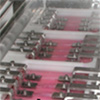| Sep 23, 2022 |
|
|
|
(Nanowerk News) A review paper by scientists at the University of Oxford discussed possible benefits of using humanoid musculoskeletal robots and soft robotic systems as bioreactor platforms in producing clinically useful tendon constructs.
|
|
The new review paper, published in the journal Cyborg and Bionic Systems (“Advanced Robotics to Address the Translational Gap in Tendon Engineering”), summarizes current trends in tendon tissue engineering and discusses how conventional bioreactors are unable to provide physiologically relevant mechanical stimulation given that they largely rely on uniaxial tensile stages.
|
|
The paper then highlights musculoskeletal humanoid robots and soft robotic systems as platforms for providing physiologically relevant mechanical stimulation that could overcome this translational gap.
|
|
Tendon and soft tissue injuries are a growing social and economic problem, with the tendon repair market in the United States being estimated at $ 1.5 billion USD. Tendon repair surgeries have high rates of revision, with upwards of 40% of rotator cuff repairs failing post-operatively. Production of engineered tendon grafts for clinical use is a potential solution for this challenge. Conventional tendon bioreactors mainly provide uniaxial tensile stimulation. The lack of systems which recapitulate in vivo tendon loading is a major translational gap.
|
|
“The human body provides tendons with three-dimensional mechanical stress in the form of tension, compression, torsion, and shear. Current research suggests that healthy native tendon tissue requires multiple types and directions of stress. Advanced robotic systems such as musculoskeletal humanoids and soft robotics promising platforms that may be able to mimic in vivo tendon loading” explained author Iain Sander, a researcher at the University of Oxford with the Soft Tissue Engineering Research Group.
|
|
Musculoskeletal humanoid robots were initially designed for applications such as crash test dummies, prostheses, and athletic enhancement. They attempt to imitate human anatomy by having similar body proportions, skeletal structure, muscle arrangement, and joint structure.
|
|
Musculoskeletal humanoids such as Roboy and Kenshiro use tendon-driven systems with myorobotic actuators that mimic human neuromuscular tissue. Myorobotic units consist of a brushless dc motor which generates tension like human muscles, attachment cables which act as the tendon unit, and a motor driver board with a spring encoder, which act as the neurologic system by sensing variables including tension, compression, muscle length, and temperature.
|
|
Proposed advantages of musculoskeletal humanoids include the ability to provide multiaxial loading, potential for loading in consideration of human movement patterns, and provision of loading magnitudes comparable to in vivo forces. One recent study has demonstrated the feasibility of growing human tissue on a musculoskeletal humanoid robot for tendon engineering.
|
|
Biohybrid soft robotics is focused on developing biomimetic, compliant robotic systems which permit adaptive, flexible interactions with unpredictable environments. These robotic systems are actuated through a number of modalities, including temperature, pneumatic and hydraulic pressure, and light. They are made of soft materials including hydrogels, rubber, and even human musculoskeletal tissue.
|
|
These systems are already being used to provide mechanical stimulation to smooth muscle tissue constructs and have been implemented in vivo in a porcine model.
|
|
These systems are attractive for tendon tissue engineering given that: i) their flexible, compliant properties allow them wrap around anatomic structures, mimicking the configuration of native tendon ii) they are capable of providing multiaxial actuation and iii) a number of the techniques used in soft robotics overlap with current tendon tissue engineering practices.Looking forward, the team envision advanced robotic systems as platforms which will provide physiologically relevant mechanical stimulus to tendon grafts prior to clinical use.
|
|
There are a number of challenges to consider as advanced robotic systems are implemented. Firstly, it will be important for future experiments to compare technologies proposed in this review to conventional bioreactors. With development of systems capable of providing multiaxial loading, it will be important to find methods for quantifying strain in 3D. Finally, advanced robotic systems will need to be more affordable and accessible for widespread implementation.
|
|
“An increasing number of research groups are showing that it is feasible to use advanced robotics in combination with living cells and tissues for tissue engineering and bioactuation applications. We are now at an exciting stage where we can explore the different possibilities of incorporating these technologies in tendon tissue engineering and examine whether they can really help improve the quality of engineered tendon grafts”, said Pierre-Alexis Mouthuy, the review article’s senior author.
|
|
In the long term, these technologies have potential to improve quality of life for individuals, by decreasing pain and risk of tendon repair failure, for healthcare systems, by reducing the number of revision surgeries, and for the economy, by improving workplace productivity and lowering healthcare costs.
|
